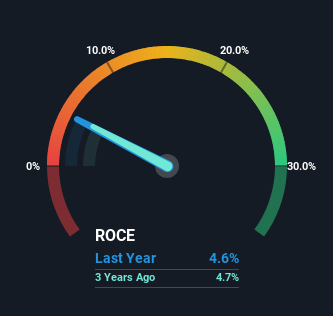- United States
- /
- Electric Utilities
- /
- NasdaqGS:EVRG
Here's What To Make Of Evergy's (NASDAQ:EVRG) Decelerating Rates Of Return
If we want to find a stock that could multiply over the long term, what are the underlying trends we should look for? Firstly, we'll want to see a proven return on capital employed (ROCE) that is increasing, and secondly, an expanding base of capital employed. This shows us that it's a compounding machine, able to continually reinvest its earnings back into the business and generate higher returns. However, after investigating Evergy (NASDAQ:EVRG), we don't think it's current trends fit the mold of a multi-bagger.
Return On Capital Employed (ROCE): What Is It?
Just to clarify if you're unsure, ROCE is a metric for evaluating how much pre-tax income (in percentage terms) a company earns on the capital invested in its business. To calculate this metric for Evergy, this is the formula:
Return on Capital Employed = Earnings Before Interest and Tax (EBIT) ÷ (Total Assets - Current Liabilities)
0.046 = US$1.2b ÷ (US$31b - US$4.8b) (Based on the trailing twelve months to September 2023).
So, Evergy has an ROCE of 4.6%. On its own, that's a low figure but it's around the 4.5% average generated by the Electric Utilities industry.
Check out our latest analysis for Evergy

Above you can see how the current ROCE for Evergy compares to its prior returns on capital, but there's only so much you can tell from the past. If you'd like, you can check out the forecasts from the analysts covering Evergy here for free.
What The Trend Of ROCE Can Tell Us
There hasn't been much to report for Evergy's returns and its level of capital employed because both metrics have been steady for the past five years. It's not uncommon to see this when looking at a mature and stable business that isn't re-investing its earnings because it has likely passed that phase of the business cycle. So unless we see a substantial change at Evergy in terms of ROCE and additional investments being made, we wouldn't hold our breath on it being a multi-bagger. That probably explains why Evergy has been paying out 69% of its earnings as dividends to shareholders. If the company is in fact lacking growth opportunities, that's one of the viable alternatives for the money.
The Key Takeaway
We can conclude that in regards to Evergy's returns on capital employed and the trends, there isn't much change to report on. Unsurprisingly, the stock has only gained 0.1% over the last five years, which potentially indicates that investors are accounting for this going forward. Therefore, if you're looking for a multi-bagger, we'd propose looking at other options.
If you'd like to know more about Evergy, we've spotted 2 warning signs, and 1 of them is potentially serious.
While Evergy isn't earning the highest return, check out this free list of companies that are earning high returns on equity with solid balance sheets.
Valuation is complex, but we're here to simplify it.
Discover if Evergy might be undervalued or overvalued with our detailed analysis, featuring fair value estimates, potential risks, dividends, insider trades, and its financial condition.
Access Free AnalysisHave feedback on this article? Concerned about the content? Get in touch with us directly. Alternatively, email editorial-team (at) simplywallst.com.
This article by Simply Wall St is general in nature. We provide commentary based on historical data and analyst forecasts only using an unbiased methodology and our articles are not intended to be financial advice. It does not constitute a recommendation to buy or sell any stock, and does not take account of your objectives, or your financial situation. We aim to bring you long-term focused analysis driven by fundamental data. Note that our analysis may not factor in the latest price-sensitive company announcements or qualitative material. Simply Wall St has no position in any stocks mentioned.
About NasdaqGS:EVRG
Evergy
Engages in the generation, transmission, distribution, and sale of electricity in the United States.
Average dividend payer with questionable track record.
Similar Companies
Market Insights
Community Narratives




